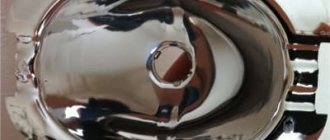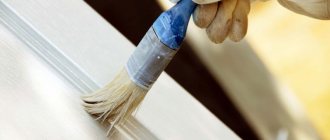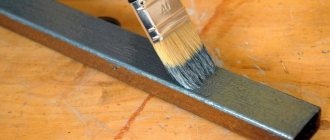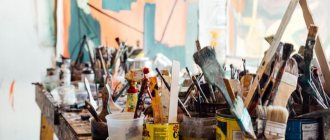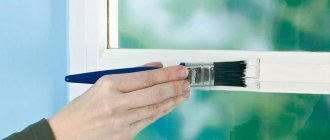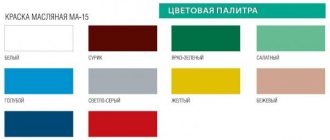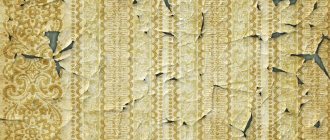Painting is a popular way to change the color of metal. To obtain the desired result, it is important to strictly follow the technology and select the paint, taking into account the operating conditions of the enamel. Painting metal allows you to change the design of the surface, protect the material from the destructive effects of moisture and the formation of rust.
Painting metal surfaces
The essence and features of the method
Painting of metal products was initially used to change color and give surfaces an interesting shade, but simple enamel quickly cracked and rust appeared underneath. Therefore, manufacturers began to develop new types of coloring compounds that could protect the metal from corrosion.
On sale you can find different types of paint that is suitable for metal surfaces. It can be applied in different ways. In this case, hand tools and industrial equipment are used.
Recommendations for selection
When choosing a coloring composition, you must follow the recommendations of experts. Exterior paint is not always suitable for interior use. At the same time, the features of applying the mixture to the surface also differ.
It is important to consider the following:
- If you need to paint heating pipes and radiators, choose a heat-resistant composition that can be used at temperatures of about 150 degrees.
- Black and gray paint work well in domestic spaces, but living spaces require brighter solutions.
- The surface of heating elements is painted before the heating season, when they are cold.
- Furnace elements are painted with compounds that can withstand temperatures up to 500 degrees.
- Non-ferrous metals are coated with special primers, because ordinary ones are not suitable for this.
- If you plan to work outdoors, use organic solvents.
Thus, when choosing a paint for metal finishing, it is important to consider many factors, including temperature, use, corrosion and rust protection, and color after treatment. Only in this case will you be completely satisfied with the result of the work.
Review of primer enamels (3 videos)
Enamels with anti-corrosion properties (40 photos)
Is it possible to paint metal?
Metal structures are often made of black iron. Since this material oxidizes very quickly, it must be protected from moisture and rust. For this purpose, special anti-corrosion compounds or metal paint can be used.
Galvanized metals, thanks to a layer of zinc and chromium, are already protected from rust. The protective layer retains its integrity for up to 15 years. If you want to increase this figure, the surfaces can be additionally painted.
Painted disc
Preparatory activities
To obtain the desired result, the painting process must be carried out with surface preparation. And also the choice of paint should be done with special attention. The combination of carefully performing all stages will help you get an excellent result with your own hands.
To obtain the desired result, the painting process must be carried out with surface preparation.
Paint selection
Before painting metal, it is necessary to analyze what functions the painting will have to perform, in what conditions the item will be used, and the type of product: fence, car, doors or other items. Then it will be easier to choose a coloring composition, and the result will be good.
Popular and common compositions suitable for painting have been described above. Here we will talk about the types that differ in obtaining special properties on the surface:
- If there is an area with rust, you can mix epoxy with chemical components, this will create a coating that delays the further spread of the lesion and a barrier against new formations;
- Hammer paints are a subtype of different paints. They are suitable for items used outdoors and create strong protection from external influences;
- Primer enamel is one product that includes the characteristics of a primer mixture and paint;
- Nitro paints are highly toxic, so they can only be used outdoors; they are produced exclusively in cans.
Hammer paints are suitable for items used outdoors and create durable protection from external influences.
Materials and tools
It is better not to interrupt painting; for this reason, make sure that all the necessary tools and materials are available in advance. You will need to prepare the following items:
- A primer solution that will suit the task at hand;
- Container for coloring composition;
- Roller, brush. The second is necessary for painting hard-to-reach places; a roller is more suitable for working with large products. You can choose a spray bottle.
It is better not to interrupt painting; for this reason, make sure that all the necessary tools and materials are available in advance.
Surface pre-treatment
To prevent painting from highlighting defects that were on the surface, you need to get rid of them. Therefore, a preparatory stage is carried out, including the following actions:
- All dirt is removed. If there is an old coating, it is better to eliminate it.
- A degreasing agent is applied, all areas should be treated, and the surface is washed again.
- After the base has dried, a putty mixture is applied to obtain a smooth base.
- Next, the rusty layer is removed, and a rust converter can be applied.
- Small flaws can be removed by sanding.
If there is an old coating, it is better to eliminate it.
Application methods
To apply paint you can use:
- Paint brush. Suitable for painting small parts. You can find brushes of different sizes on sale. The bristles can be natural or synthetic. For access to hard-to-reach places, the tool is equipped with an elongated curved handle.
- Roller. Suitable for painting large flat surfaces.
- Sprayers. The second name for the spray gun. A compressor is used to operate them. The coloring composition is supplied under pressure. The equipment is used by large enterprises, car repair shops, carpentry, and blacksmith shops.
- Containers for dipping metal workpieces. This method makes it easy to paint parts with complex shapes.
Modern technology - powder coating of metal. The blanks are placed in a closed spray booth and covered with a layer of paint. Its particles receive a negative electrical charge and are attracted to the working surface, creating a dense, uniform layer. After applying the powder, the workpiece is placed in an oven so that the decorative layer bakes and becomes monolithic.
Paint brush
Features of oil compositions
Drying oil is used to make this type of emulsion. The advantages of this type include:
- Environmentally friendly composition;
- No pungent odor;
- Affordable price.
In addition to the advantages of the coloring composition, there are significant disadvantages.
They are as follows:
- After drying, the metal does not have a protective film that prevents moisture penetration;
- The decorative layer is not able to withstand ultraviolet radiation. Sun rays cause pigment to fade;
- Enamels of this type have a short service life.
Types of coloring compositions
Varieties:
- Oily. Suitable for decorative finishing of surfaces indoors and outdoors. Made from organic substances. Before applying oil paint, you need to cover the working surface with primer. The main disadvantage is the persistent pungent odor. Such enamels can only be used in ventilated areas.
- Epoxy. Manufactured on the basis of silicone resin. In order for the composition to set, different hardeners are used. Can only be used for exterior painting as they are highly toxic. It is difficult to work with epoxy paints, but the finished coating reliably protects surfaces from rust.
- Acrylic. The basis of such paints are polymers. Suitable for painting metal parts indoors.
- Alkyd. Used for external and internal work. Easy to apply, no primer required.
- Rubber. Special dyes used to coat the external sides of building walls and roofs. Withstands prolonged exposure to moisture and ultraviolet radiation.
For metal, you need to choose paints that protect against rust. Before painting, the surfaces must be coated with a primer containing a high zinc content.
How to calculate paint consumption?
The paint consumption for metal can be found on the container. It is indicated on the back of the label or front side. If for some reason there is no designation, you need to know that 1 liter is enough for about 14 m2.
Consumption depends on the application method, the presence of complex elements, surface structure, and type of paint.
Applying paint on rust
When performing repair and construction work, it is important to remember that all metal elements need protection. They require the use of anti-rust products that can last for a long time. You can pay attention to coloring, priming and primer-enamel compositions. They differ in similar characteristics in terms of drying time, shade and composition, as well as technology of use.
Metal paint for exterior use requires preliminary preparation. The treated area is cleaned of rust, dirt and dust. If necessary, it is degreased. Often special products designed for rusty metal are used. This can be an enamel primer that will prime and clean the metal surface. To obtain a rich shade, the composition is applied in two layers.
Rust paint has the following positive aspects:
- the ability to apply directly onto rust;
- the ability to create a weather-resistant coating;
- increased covering ability;
- increased quality of adhesion, even if there is a rusty layer;
- good corrosion resistance;
- quick drying;
- long service life up to 8 years;
- many different shades.
Paint for metal and rust is prohibited for processing equipment if during operation the surface temperature heats up above 150 degrees. Such compositions should not be applied to surfaces in contact with drinking water, as this may be hazardous to health.
In the video: Hammerite metal paint.
Primer enamel for rust
Similar compositions are applied to various surfaces made of metal. They are actively used against rust for outdoor work. There is no need to use primers before applying enamel to the surface. This is due to the fact that primer with enamel is a combination of the advantages of a primer mixture, anti-corrosion paint and enamel for metal surfaces. As a result, the sequence of work with primer-enamel is greatly simplified, and all you have to do is follow simple recommendations.
First of all, the metal surface must be cleaned of traces of grease, dirt and dust. The top layer of rust is also removed. To do this, you can use sandpaper or a metal spatula (brush). Then you need to wipe the surface using a solvent.
The primer-enamel is mixed well and applied over the iron in two layers. When the first layer is applied, you must wait at least 30 minutes. This is the minimum period required for interlayer drying. The maximum period before applying a second coat can be extended to 5 hours. If you exceed this time, you will have to postpone work for up to 30 days.
When using enamel on metal, strictly follow the instructions on the package. It is important to carry out work on the most available day in order to apply the required number of layers to the surface in a timely manner.
Anti-corrosion paint compositions
Metal paints are capable of providing high-quality surface protection from corrosion and premature loss of original properties. Experienced professionals use good quality paint for exterior metal work. The costs are recouped quickly, since you do not have to renew the coverage annually.
Anti-corrosion paints are represented by quick-drying one-component compositions that include anti-corrosion pigments and synthetic resins. They provide effective corrosion control and a finishing coating with high decorative characteristics.
White paint is ideal for pipes and other metal surfaces. But you can choose any other shade.
Using paints designed for metal, you can achieve a semi-gloss, gloss or hammer finish. At the same time, the composition resists the accumulation of dirt, which contributes to the formation of rust on the painted surface. Such compositions can be used not only in suburban construction, but also in industrial production.
Enamels are used for painting water and gas pipes, machine tools and roofs, as well as in the process of creating agricultural tools. They can be used to protect any surfaces that need protection from rust formation processes.
Exterior paint includes high molecular weight silicones, which gives the composition additional properties. They prevent the negative effects of moisture on metal parts.
Which paint is best is up to you to decide, taking into account the specific features of use in your home. Thanks to its wetting properties, it can be used on unprepared surfaces without prior priming. The composition is applied to the surface in the temperature range from -20 to +80 degrees. This allows the use of paint containing oils in humid and hot climate zones.
Advantages and disadvantages of the method
The pros and cons of painting metal depend on the type of paint composition used. Advantages of painting metal surfaces, provided the technology is followed:
- Getting the required shade. You can find different colors on sale.
- Availability of consumables.
- Easy to apply paint using a brush or roller.
- Protection against rust formation.
Flaws:
- Many types of coloring compounds emit a persistent, unpleasant odor. The room needs to be ventilated for a long time.
- For powder coating you will need special equipment, a spray booth.
- Not all types of paint protect metal from corrosion.
Most of the shortcomings can be leveled out if you buy a high-quality coloring composition and carry out the work strictly following the technology.
What is alkyd paint
For the manufacture of such compositions, pentaphthalic varnish is used. The positive qualities of this paint are:
- Formation of a dense shell;
- Affordable price;
- Durability;
- Reliability;
- Decorative appearance.
The disadvantages include:
- Acrid odor after application;
- Highly flammable.
More than 10 years ago, alkyd enamel was developed for working with a metal base, but decades later it began to be used for treating other surfaces.
Coloring at home
If necessary, metal products can be painted yourself. To do this, you need to choose a method for applying enamel, prepare the required tools and surfaces, and apply the composition.
Tools and equipment
For the classic method of painting metal, you need to prepare:
- roller, brushes of different widths;
- paint container;
- the coloring composition must be shaded;
- primer for metal.
Additionally, you will need masking tape and plastic film.
Surface preparation
Do not apply paint to unprepared surfaces. Before starting work, you need to perform several steps:
- Clean the metal from dirt and rust. To do this, you can use a grinder, grinder, metal brush or acid.
- Degrease surfaces with solvent.
- Putty the uneven areas.
After the preparatory work, you can apply a primer.
Preparation of material
Application of the composition
Surfaces that do not need to be painted should be covered with plastic film. The edges must be covered with masking tape. Painting with a brush is easy. It needs to be dipped 1/3 of the way. The number of layers depends on the desired result.
Review of popular manufacturers
Among the popular manufacturers note:
- Prestige. This product is quick-drying and has increased adhesion to the surface. The paint has all the necessary certificates of conformity. The final coating is smooth and stable in the environment.
- Kerta. This matte black paint can withstand high temperatures (up to 900 degrees). A special feature of the product is its resistance to extremely low temperatures. The manufacturer also offers other colors to choose from. The characteristics vary depending on the color.
- Hammerite. This product can be applied to metal and rust. The composition is considered universal due to the use of 3 in 1 technology. It does not require prior coating in the form of a primer before application.
Two-layer enamel is able to protect the metal surface for a long time. The main thing is to choose the appropriate composition for the operating conditions.
Recommendations and safety precautions
Safety regulations:
- The room in which the work will take place must be well ventilated.
- If the solvent is spilled, the resulting stain must be covered with sand.
- You should work in a respirator, safety glasses, gloves, and long-sleeved overalls.
- The remaining paint must be poured into a separate container and sealed tightly.
- Used jars should be washed or thrown away.
Do not pour any remaining paint down the drain.
Metal painting is performed to change the shade of the product and protect the material from rust. To obtain the desired result, you need to choose one of the possible methods of applying the coloring composition and select the paint. Attention should also be paid to the preparation of metal surfaces. Without it, the decorative coating will be destroyed in a short period of time.
How to calculate paint consumption
Before painting a metal product, you need to calculate the amount required for the job. The manufacturer always writes the average product consumption on the packaging of the product. The indicator may vary somewhat; it is influenced by the application tool, surface structure, coloring agent, and the presence of complex elements on the object.
The manufacturer always writes the average product consumption on the packaging of the product.
Powder paint compositions
Application of powder paint in industry
Among the components are:
- film formers;
- pigments and fillers;
- plasticizers;
- modifiers;
- hardeners and accelerators;
- auxiliary additives
Characteristics of film former:
- They are solids that can be in amorphous or crystalline form.
- They are loose powders.
- Low melting temperature and melt viscosity.
- A film is formed through the melts when heated.
- They have a high destruction temperature.
Powder paints, based on the type of film formers that form their basis, are divided into:
- thermoplastic;
- thermosetting.
Thermoplastics do not undergo chemical changes when heated and have become more widespread due to:
- stability of the resulting compositions;
- rapid formation of coatings;
- availability.
The main disadvantage of thermoplastic film formers is their low adhesive strength.
Thermoplastic paints include:
- polyethylene;
- polyvinylbuteral;
- polyvinyl chloride;
- polyamide;
- pentaplast and others.
When heated, thermosets undergo a chemical polymerization process and have:
- increased adhesion;
- can form thin coatings with excellent appearance due to low viscosity;
- reduced temperature conditions of formation;
- high-quality coating characteristics under operating conditions.
One of the disadvantages of thermosetting film formers is the increase in coating formation time.
Thermosetting types include:
- epoxy;
- polyester;
- polyacrylate;
- polyurethane;
- epoxy-polyester, etc.
Pigments and fillers
In addition to the standard requirements, powder paints additionally have:
- ease of dispersibility in the melt of the film former;
- resistance to the temperature at which the coating is formed, without changing color or decomposing at the same time;
- inertness to other components of the composition.
When produced by dry mixing, pigments and fillers should encourage:
- increased flowability;
- reducing clumping and caking properties;
- improvement of “boiling”;
- applying powders to the surface.
The following properties of powders and coatings can be controlled using fillers and pigments:
- electrification;
- heat resistance;
- thermal conductivity;
- electrical conductivity;
- magnetic properties;
- wear resistance;
- adhesive strength;
- flammability;
- biological inertia;
- damping capacity.
The use of metal powders as fillers makes it possible to obtain an imitation of metal surfaces. A significant difficulty in pigmenting powder paints is tinting the color in accordance with the RAL color standard.
In the absence of pigments and fillers in powder coating materials, it is possible to obtain transparent varnish coatings.
Plasticizers
Powder coating
In powder paints, they influence both the physical and mechanical properties of coatings and the temperature and time of film formation. In addition, plasticizers must:
- do not disturb the aggregative properties of the polymer;
- do not degrade technological characteristics (flowability, granulometric composition, etc.);
- function at film formation temperature.
Solid plasticizers cope better with the requirements, the main disadvantage of which is incomplete compatibility with polymers. To eliminate this drawback, combined mixtures of solids and liquids are used.
Modifiers, hardeners and auxiliary additives
Modifiers are capable of improving performance through physical or chemical modification. At the same time, physical modification through the addition of various film formers has become most widespread. Modifiers also regulate the technological parameters of powder paint, such as melt viscosity, flow temperature and powder flowability.
Hardeners are a necessary component of paints based on thermosetting film formers. To activate the curing process, accelerators corresponding to specific hardeners are used. If for the curing process of two-component liquid paints it is enough to mix the components, then in powder paints all components are in the original composition without interaction. Hardeners are activated only at the “sintering” temperature, “launching” the curing process after the film former has melted and a liquid film has formed.
The curing system is an important component of thermosetting paints, on which not only the stability and curing conditions depend, but also the performance characteristics of the resulting coating (appearance, physical, mechanical and protective properties).
Auxiliary additives can increase:
- atmospheric resistance of the coating due to reduced photodestruction of polymers when exposed to solar radiation;
- resistance to temperature changes;
- powder flowability;
- melt spreading, etc.
Powder paint production technology
Common manufacturing options:
- Dry mixing of components.
- Mixing of components in the melt followed by disintegration to the required size.
The method of producing powders by drying sprayed liquid paints has not become widespread due to significant losses of solvents and the high cost of paints.
Dry mixing of components is the main option for producing powder paints from thermoplastic materials. Production is done without expensive equipment and significant labor costs. The difficulty lies in obtaining stable, non-separating compositions during storage and use with a uniform distribution of small additives.
Mixing the components in the melt produces high-quality homogeneous powders with a stable composition and structure. The method is lengthy, has many stages, and requires expensive and complex equipment. Can be used for any solid film formers, but is mainly used for thermosets.
How to coat metal before painting?
The most common are alkyd primer for metal GF-021 and epoxy EP-0010. It is applied mainly to ferrous metals. Its low price can be considered an advantage. Phosphating is used for surfaces of non-ferrous and ferrous metals.
Interesting materials:
How to quickly fatten a rabbit? How to quickly wash window blinds? How to quickly cook butter? How to quickly germinate parsley? How to quickly germinate parsley seeds? How to dry things quickly? How to quickly stretch new shoes? How quickly do honey mushrooms grow? How quickly does the labor inspectorate respond to a complaint? How to quickly remove dye from hair?
Paint for metal surfaces
When carrying out interior finishing work, as well as painting drainage systems, fences, etc., metallic paint is often used. This paint product is most suitable in cases where there is a need to create a “antique” effect. Metal paint is mainly applied to the surface of moldings, plinths, support columns, enclosing structures, various lamps, railings and decorative vases.
The paint, which has a structure consisting of natural metal components and mica, makes it possible to create the appearance of any surface with the effect of old iron, copper, as well as paint any object in gold or bronze. Metallic paint is supplied to the consumer market in plastic packages of 0.5 and 2.5 liters for applying the underlying layer and 1-4 liters for applying the final coat of paint. A similar product for painting metal, wood, plastic and other surfaces is made on a water basis and does not contain toxic substances.
This material is easy to store and does not cause any particular difficulties in use, but to obtain the maximum positive effect from painting the surface with this product, you must adhere to some established rules. Such materials should be stored in tightly sealed containers, keeping the storage away from direct sunlight.
The storage temperature of paints ranges from minus 15 to plus 25 degrees. Before applying the material to the surface, it must be warmed to room temperature. In general, the optimal shelf life of rust paint is no more than six months.
